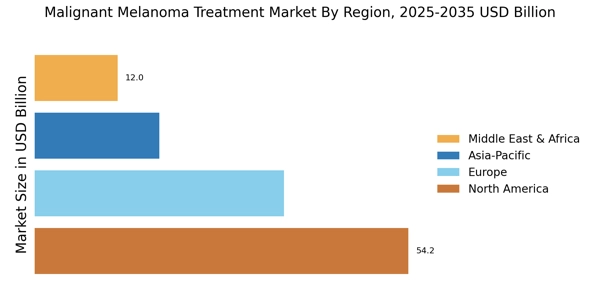Increasing Incidence of Melanoma
The rising incidence of malignant melanoma is a primary driver for the Malignant Melanoma Treatment Market. According to recent statistics, melanoma cases have been increasing at an alarming rate, with estimates suggesting that the number of new cases could reach over 100,000 annually in certain regions. This surge in incidence is attributed to factors such as increased sun exposure, tanning bed usage, and genetic predispositions. As awareness of skin cancer grows, more individuals are seeking early diagnosis and treatment options, thereby propelling the demand for innovative therapies. The Malignant Melanoma Treatment Market is likely to experience significant growth as healthcare providers and pharmaceutical companies respond to this urgent need for effective treatment solutions.
Regulatory Support for New Therapies
Regulatory bodies are increasingly supportive of the development and approval of new therapies for malignant melanoma, which is a key driver for the Malignant Melanoma Treatment Market. Streamlined approval processes and incentives for orphan drugs have encouraged pharmaceutical companies to invest in melanoma treatments. This regulatory environment not only facilitates faster access to innovative therapies for patients but also stimulates competition among manufacturers. As a result, the market is expected to witness a diverse range of treatment options becoming available, enhancing patient choice and potentially improving outcomes. The ongoing support from regulatory agencies is likely to play a crucial role in shaping the future of the Malignant Melanoma Treatment Market.
Rising Investment in Cancer Research
The Malignant Melanoma Treatment Market is benefiting from increased investment in cancer research and development. Governments and private organizations are allocating substantial funds to explore new treatment avenues, including novel drug formulations and combination therapies. This influx of capital is fostering innovation and accelerating the pace of clinical trials, which is essential for bringing new therapies to market. As research continues to unveil new insights into melanoma biology, the potential for groundbreaking treatments emerges. The market is likely to see a surge in new product launches, driven by these investments, which could reshape the landscape of the Malignant Melanoma Treatment Market.
Advancements in Treatment Technologies
Technological advancements in treatment modalities are significantly influencing the Malignant Melanoma Treatment Market. Innovations such as targeted therapies and immunotherapies have revolutionized the approach to melanoma treatment, offering patients more effective options with fewer side effects. For instance, the introduction of checkpoint inhibitors has shown promising results in improving survival rates among advanced melanoma patients. The market is projected to expand as these technologies continue to evolve, with research indicating that the global market for melanoma therapies could exceed several billion dollars by the end of the decade. This trend underscores the importance of ongoing research and development in the Malignant Melanoma Treatment Market.
Growing Awareness and Screening Programs
Increased awareness about skin cancer and the importance of early detection is driving the Malignant Melanoma Treatment Market. Public health campaigns and educational initiatives have led to a greater understanding of melanoma risk factors and symptoms, encouraging individuals to seek regular skin checks. As a result, more cases are being diagnosed at earlier stages, which is crucial for effective treatment. The implementation of screening programs in various healthcare systems has also contributed to this trend, potentially leading to a higher demand for treatment options. This heightened awareness is expected to sustain growth in the Malignant Melanoma Treatment Market as more patients are identified and treated promptly.


















Leave a Comment